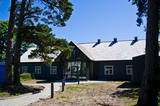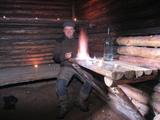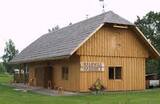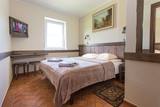| Нo | Название | Описание |
|---|---|---|
|
Трактир обосновался в старинном срубе неподалеку от Лиелпупской церкви. В старом амбаре рядом с трактиром по рецептам предков делают мясные и колбасные изделия, которые можно купить в мясной и колбасной лавке Sidrabiņi. Предлагаются экскурсии и дегустация продукции. |
||
|
"Gusts Apinis" is located in Vidzeme highlands, Amata region. The company is unique in that it grows non-traditional crops in Latvia: quinoa, amaranth, millet, lentils, etc. Produces flour and pasta (buckwheat, buckwheat-quinoa) from grown products. |
||
|
The campsite is located 77 km from Riga, surrounded by beautiful forest and sea. The range of offers is wide - beach volleyball court, basketball court, windsurfing, table tennis and more. There are tent sites as well as double or quadruple camping houses. There are facilities for people with reduced mobility. The campsite is open from 1 May until 31 October. Large WC and shower room (shared). |
||
|
Atrodas Raiņa ielā 18. Baznīca celta 1911. - 1912. g. pēc Stukmaņu muižas nomnieka barona R. Noldes iniciatīvas. 1. pasaules karā cietušo baznīcu atjaunoja un no jauna iesvētīja 1921. g. Baznīcā apskatāma altārglezna “Kristus augšāmcelšanās”. Dievnams tāpat kā daudzas citas pilsētas ēkas ir būvētas no apkaimē sastopamā izejmateriāla – dolomīta. Interesanti, ka tornis būvēts ēkas vienā malā – asimetriski. |
||
|
Моленная Пудеревской старообрядческой общины. Архитектурный памятник местного
значения, построенный в начале 20 века.
|
||
|
В лесном хозяйстве Männiku используются местные продукты ‒ прежде всего растительного происхождения. Здесь накоплен многолетний опыт производства продуктов питания из разнообразного растительного сырья, что привлекает в хозяйство гостей со всего мира. Принимаются только группы. |
||
|
Livonian Community House at Kolka was opened in 2019. It is a place where you can get to know the Livonian culture of Northern Kurzeme, learn about traditional activities, listen to the sound of the language, and get an idea of the cultural and historical heritage of the coast. In House you can organize and attend cultural events, seminars, trainings, exhibitions, and also receive tourism information. |
||
|
Двигаясь по дороге Нерете – Илуксте, храм виден издалека. Церковь построена в 1805 году, а отреставрирована - в 1888 г. Внутри церкви сохранился первоначальный алтарь, кафедра и фасад органа. У церкви захоронены немецкие солдаты, павшие во время Первой мировой войны. На западной стене здания помещены две мемориальные доски в память погибших во время Первой мировой войны и репрессированных в советское время жителей Лашу. |
||
|
В давние времена проспект Курмаяс был главной дорогой, ведущей на пляж. Вдоль проспекта стоят роскошные дома и виллы рубежа XIX – XX века, принадлежащие аристократам – обожателям моря и побережья. Здесь установлены отлитые в бронзе скульптуры из гимна Лиепаи «Город, в котором рождается ветер» - «Лодочник», «Янтарные латыши», «Ворона» и др. В конце проспекта возвышается памятник погибшим морякам и рыбакам (установлен в 1977 г.). Он символизирует женщину, которая ждет возвращения домой своего мужчины. На проспекте Курмаяс 16/18 находится Лиепайский историко-художественный музей. Музейный фонд (всего более 100 000 экспонатов)разместился в построенном в 1901 году в стиле эклектизма (с элементами готики) доме, который строился по эскизам берлинского архитектора Эрнеста фон Ине и проекту П. М. Берчи. В экспозиции представлена каменная стела – единственная подобного рода находка в странах Балтии с могильника под Гробиней (могильник Скандинавов). |
||
|
На хуторе лесных братьев на границе Эстонии и Латвии вы можете во время похода лесных братьев разыскать места, в которых они прятались, побывать в бункере, послушать реальные истории военного времени, послушать шум леса и спеть вместе с хозяином песни лесных братьев. Тем, кто ищет приключений, предлагается возможность переночевать в бункере. В зимнее время хутор лесных братьев предлагает покататься на санках и на санях. |
||
|
This is the thickest and tallest common ivy in Latvia. It is in the park of the Zentene Estate, opposite the mansion (which is now a school).
|
||
|
Посещение питомника по выращиванию деревьев «Селия» и захватывающий рассказ его хозяина А.Мендрика о выращивании яблонь. Экскурсия по яблоневому саду, яблочным складам и производственным цехам. Дегустация яблочного сока и рассказы из жизни виноделов за бокалом вина. |
||
|
Парк усадьбы Ильзенберг отличается смешанной планировкой и сохранился в почти первозданном виде — таким, каким он был создан во второй половине XIX в. на живописном месте с выразительным рельефом, между озерами Апваласас и Ильгис. При восстановлении парка была сохранена его пространственная структура. Парк занимает 10 га и состоит из двух частей. Первая — это сравнительно правильная прямоугольная территория у дворца, ограниченная рядами сердцевидных лип и пейзажными группами местных и интродуцированных деревьев. Вторая часть представляет собой зеленые насаждения по типу естественного леса. Старый дуб из парка усадьбы Ильзенберг объявлен объектом природного наследия и находится под охраной государства. Охват ствола этого гиганта составляет 6,3 м, диаметр — 2 м, а высота — 30,5 м. |
||
|
Построенная около 1625-го года, она на протяжении нескольких сотен лет была главным святилищем общины суйтов, опорой ее духовности и идентичности. В 1882-м году церковь была расширена в сторону, что придало ей теперешнюю форму креста. Здесь вы можете осмотреть работы голландского резчика по дереву Иоганна Мертенса. Церковный орган, созданный в 1893-м году в Екабпилсе, был построен Ф. Вейзенборном. Под церковью находится замурованное родовое захоронение Шверинов. |
||
|
В мастерской плотника предлагают особые экскурсии и мероприятия для взрослых и детей, разработаны тематические программы. Под руководством мастеров можно опробовать в работе традиционные деревообрабатывающие инструменты и освоить старинные игры, в заключение угоститься чаем, придающим силы, и устроить пикник в романтическом Доме костра. Можно купить деревянные сувениры и сделать заказы. |
||
|
"Sabiles laivas" Talsu novadā piedāvā laivu nomu, laivu un laivotāju transportu. |
||
|
This is a small area with lots of different terrains – high hillocks, distinct river valleys, thermal streams, continental dunes, etc.
|
||
|
Наш гид встретит вас в Рижском аэропорту. Экскурсия по Старому городу в Риге и Центральному рынку, внесенному в список мирового наследия ЮНЕСКО. На следующий день отправимся к фермеру, выращивающему картофель около Иецавы, а также посетим успешное местное многоотраслевое сельскохозяйственное предприятие в Тервете, которое объединяет коневодство, пивоварню, выращивание зерновых культур, молочную ферму и производство био-энергии. Мы также посетим одного из крупнейших производителей, выращивающего лекарственные травы и изготавливающего травяные чаи. После дня насыщенных рабочих визитов, отведаем традиционные латышские блюда и пиво. Затем посетим двоих скотоводов в Сигулде и области Цесиса, взберемся на башню Турайдского замка с его замечательным панорамным видом и пройдемся по очаровательным улочкам Цесиса. Затем посетим экологическую овечью ферму около Валки и остановимся на ночлег в мельнице Кони, где до сих пор обрабатывают шерсть традиционными методами. Через границу, в Эстонии, посетим выращивателей зерновых культур в области Валги. Посетим Эстонский Фермерский Союз и увидим город Тарту. Затем прогуляемся по живописному Старому городу в Таллине. Посетим молочное хозяйство в Саку и закончим визитом в Национальный парк Лахемаа. |
||
|
Viesu nams "Igne" ir vieta, kur palikt uz vienu nakti vai apmesties uz ilgāku laiku. Tā atrodas netālu Druskininkai Jaskoniai ciematā, tikai 4 km attālumā no pilsētas centra, taču tā ir klusa vieta prom no pilsētas burzma. Iespēja uzņemt līdz 50 cilvēkiem istabās ar labierīcībām. Apmeklētāju ērtībai augstas klases restorāns "Romnesa", omulīga sauna, bezmaksas autostāvvieta un bezvadu internets. Piemērota vieta konferencēm, semināriem, privātiem un korporatīviem pasākumiem. Tiek piedāvātas izglītojošas meistarklases šakotis gatavošanā, Šakotis muzeja apskate. |
||
|
Der weiteste Nordpunkt der Insel Hiiumaa. Der höchste Leuchtturm Estlands aus Roheisen (1873 – 1875) und das Denkmal zur Errinerung an die bei dem Unglück des Schiffes ‘Estonia” Umgekommenen. |
||


























